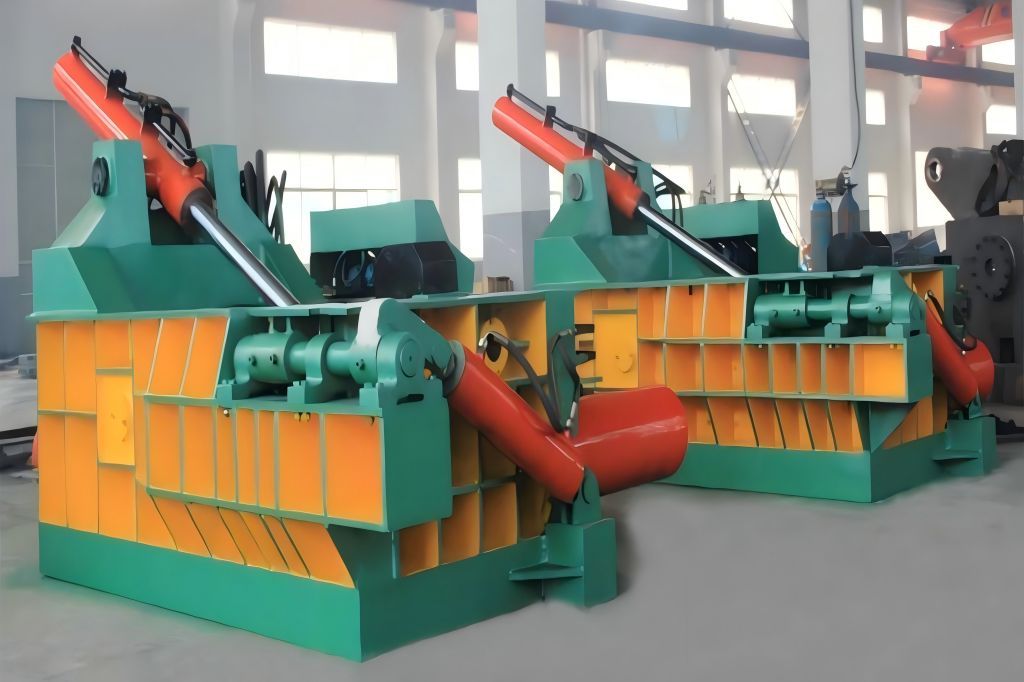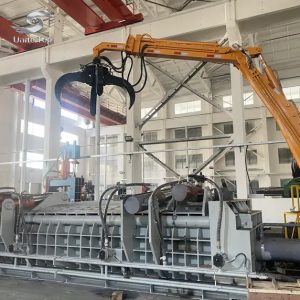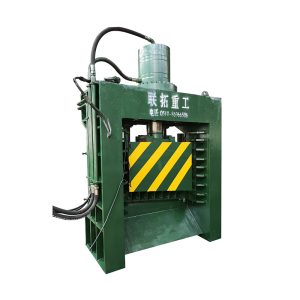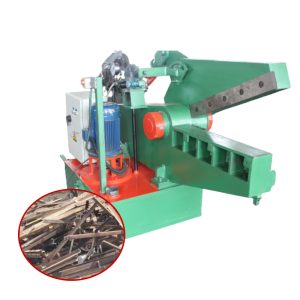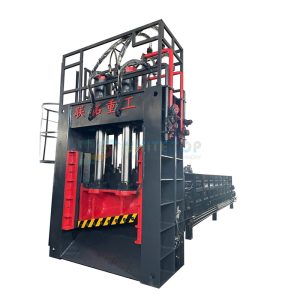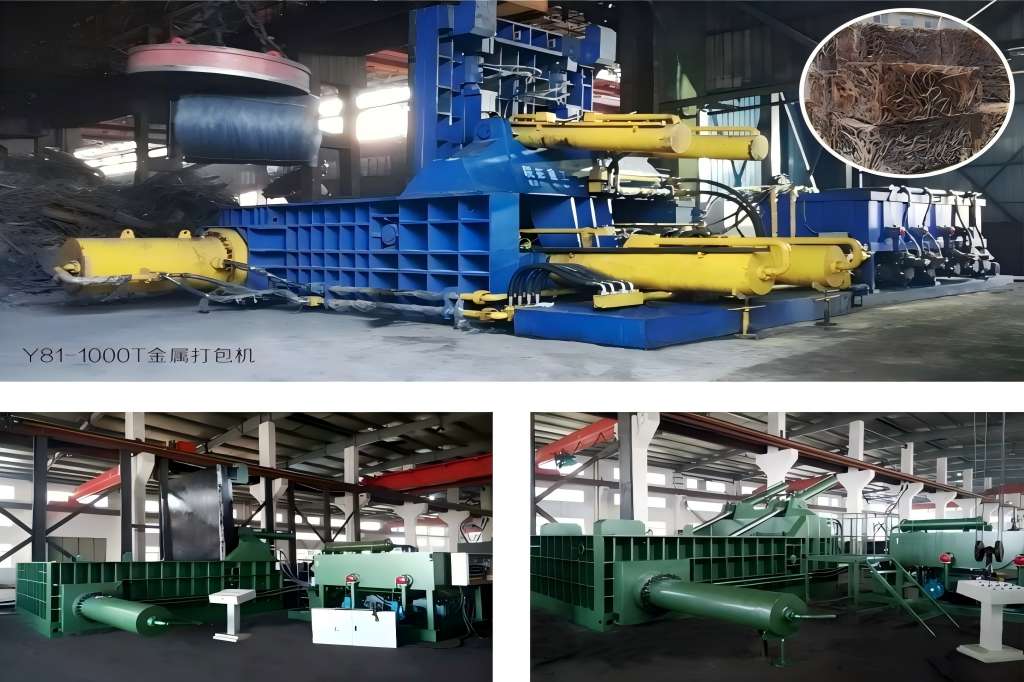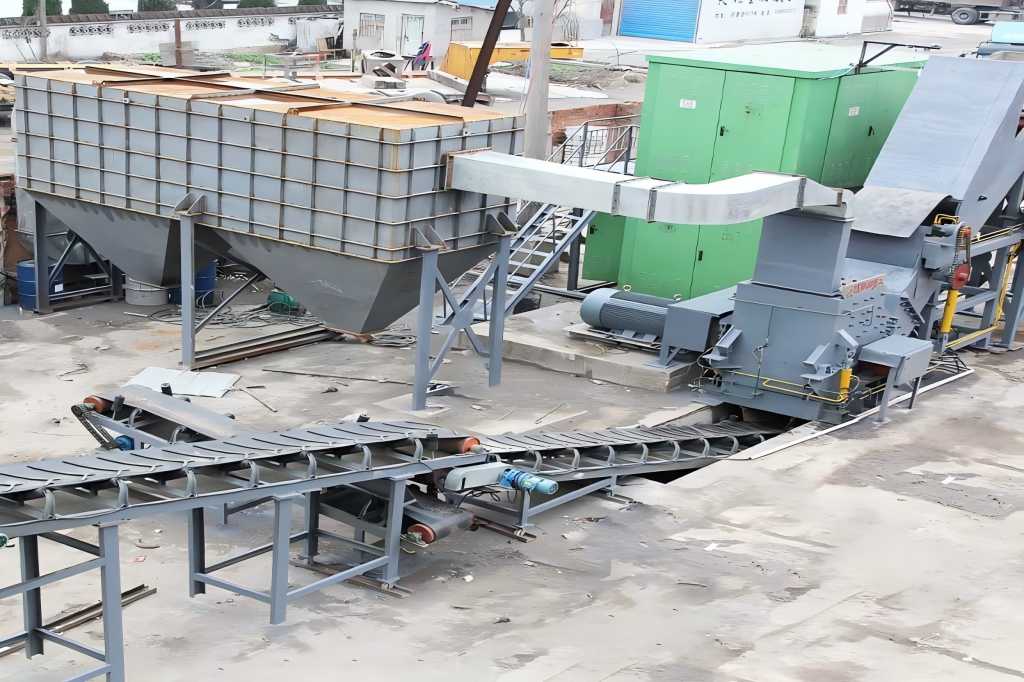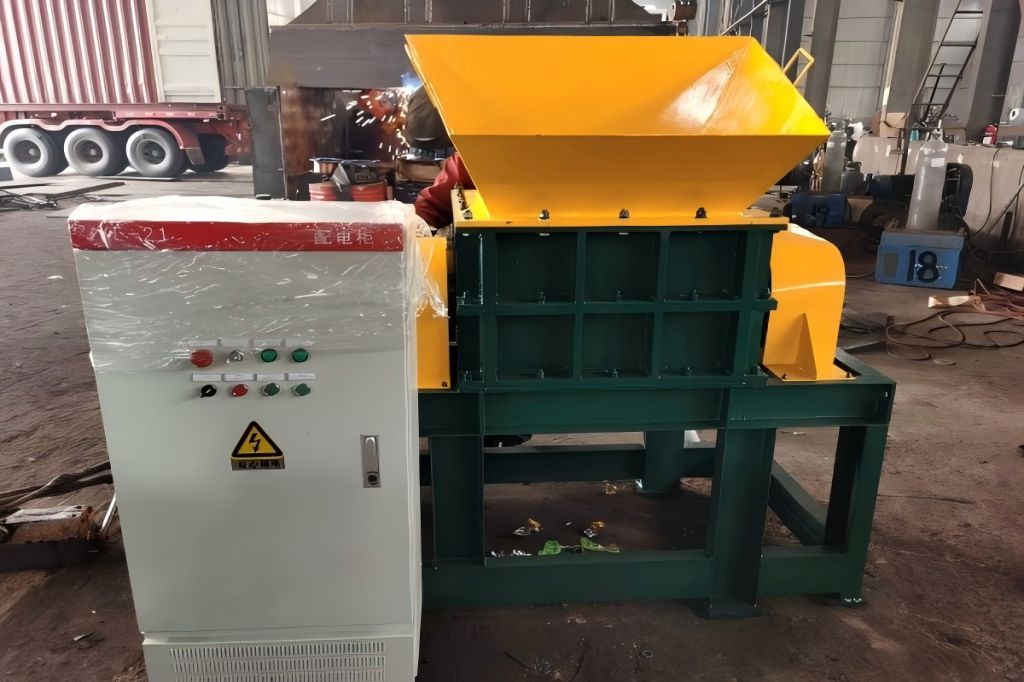Scrap metal balers are essential tools in recycling, helping industries compress metal waste into compact bales for easier transport and storage.
This article outlines eight essential steps for using a scrap metal baler and provides an overview of how the machine works and the types available.
What is a Scrap Metal Baler and Its Key Parts
A scrap metal baler is a powerful machine designed to compress scrap metal into dense, compact bales. These bales compress the material, significantly decreasing its volume, which simplifies handling, transportation, and storage. In metal recycling facilities, balers are used to process both ferrous (iron and steel) and non-ferrous metals (aluminum, copper, brass).
Parts of a Scrap Metal Baler
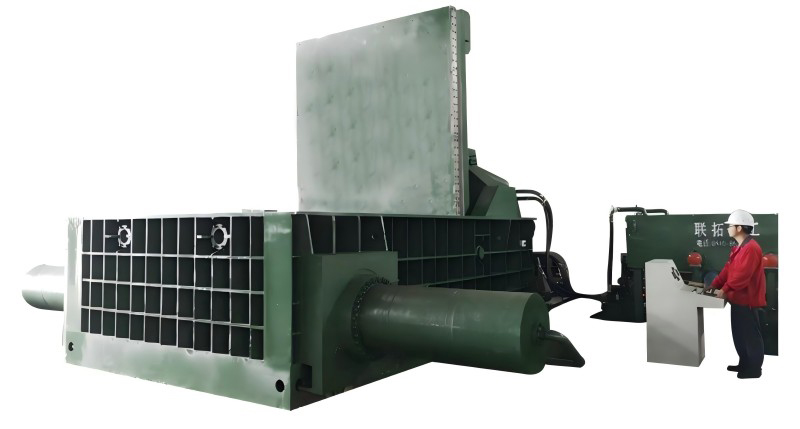
Hydraulic Cylinder
The hydraulic cylinder provides the force necessary to compress the scrap metal. It transforms hydraulic pressure into mechanical energy, driving the ram to compress the metal into tightly compacted bales.
Ram
The ram is a large, heavy plate or block that moves back and forth within the bale chamber. It applies the force generated by the hydraulic cylinder to compress the scrap metal. The ram’s movement is central to the baling process.
Oil Filter
The oil filter keeps the hydraulic fluid clean and free from impurities, which helps preserve the hydraulic system’s efficiency, ensuring smooth performance and minimizing wear on other parts.
Pressing Lid
The pressing lid is a cover that holds the scrap metal in place during the compression process. It ensures that the metal stays within the chamber while being compressed, contributing to the uniformity of the bale.
Bale Chamber
The bale chamber is the main compartment where the scrap metal is placed and compressed. It is built to endure the intense pressure applied by the ram and the hydraulic system. The size of the chamber determines the size of the final bale.
Control Panel
The control panel allows the operator to manage and control the various functions of the baler, such as setting the compression force, starting the machine, and managing the ejection of the bale. It is the central point for operating the baler safely and efficiently.
Ejection System
The ejection system, either automatic or manual, is responsible for removing the finished bale from the chamber after compression. This system is engineered to safely and efficiently discharge the heavy, compressed bales.
Hydraulic Pump
The hydraulic pump powers the hydraulic system by pumping hydraulic fluid to the cylinder. It generates the necessary pressure to run the machine and compress the metal.
Safety Mechanisms
Safety systems, including emergency stops, safety guards, and interlocks, are incorporated into the baler to protect the operator. These features ensure the machine can be instantly shut down in an emergency situation.
Binding Mechanism
The binding mechanism secures the compressed bale using wires, straps, or other binding materials. This is essential to ensure the bale retains its shape and structural integrity during both storage and transportation.
Comprehending the Purpose of a Scrap Metal Baler
The primary role of a scrap metal baler is to compress loose scrap metal into compact bales. These bales are simpler to transport, store, and market to metal processors and recyclers. Without a baler, handling and transporting loose metal would be inefficient and costly. Balers play a vital role in streamlining the recycling process by reducing the volume of metal waste.
Advantages of Using a Scrap Metal Baler
- Space Efficiency: Compressed bales require far less space than loose scrap metal.
- Improved Transportation: Compact bales are more straightforward to load and transport, helping to reduce logistics costs.
- Enhanced Recycling Efficiency: Scrap metal in bales is easier to sort, process, and melt down at recycling facilities.
Types of Scrap Metal Balers
There are various types of metal balers designed to handle different metal types, sizes, and volumes:
- Vertical Balers: Best suited for smaller operations with limited space, these balers compress the metal vertically. They are ideal for lighter, non-ferrous metals.
- Horizontal Balers: Used in larger-scale operations, horizontal balers compress the metal horizontally and are suitable for handling heavier metals like steel.
- Hydraulic Balers: These machines rely on hydraulic pressure to compress metal, making them powerful enough to handle both ferrous and non-ferrous metals.
- Manual Balers: These are simpler machines requiring manual operation, often used for small-scale or occasional baling needs.
Step-by-Step Overview of the Baling Process
Now that we understand what a scrap metal baler is and the different types available, let’s walk through the eight essential steps of operating one effectively.
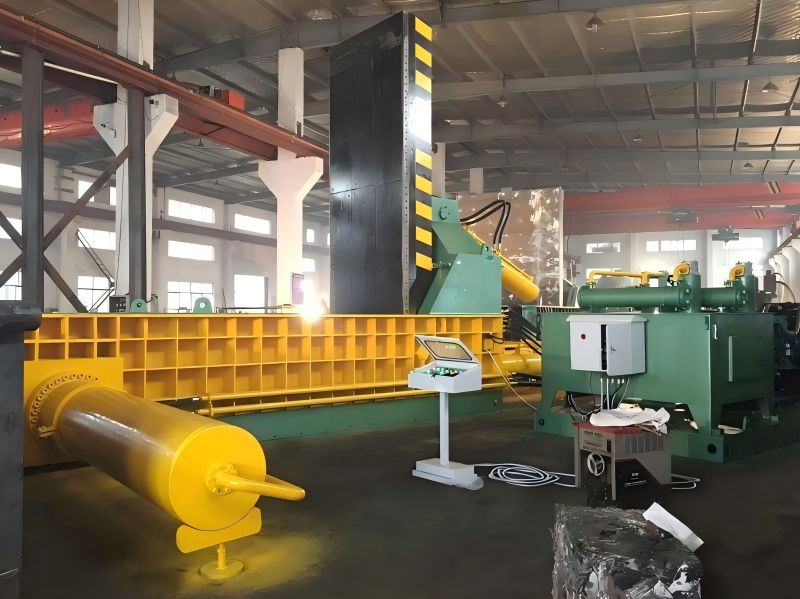
Step 1: Pre-Sorting and Preparing the Scrap Metal
Before loading the metal into the baler, it is important to pre-sort and prepare the scrap. Sorting different types of metals (ferrous vs. non-ferrous) ensures efficient baling and prevents damage to the machine.
- Importance of Sorting: Different metals have varying densities and properties. Sorting them correctly ensures proper compression and prevents contamination of the bales.
- Remove Contaminants: Any non-metallic contaminants such as plastics, oils, or rubber should be removed. These materials can degrade the quality of the bale and cause long-term damage to the baler.
- Efficiency Boost: Pre-sorting the scrap increases the machine’s efficiency and prolongs its life by reducing wear and tear.
Step 2: Loading the Scrap Metal into the Baler
Once the scrap metal is sorted and prepared, it’s time to load it into the baler’s compression chamber.
Safety Tips for Handling and Loading Metal
- Use the correct safety gear, such as gloves, goggles, and steel-toed boots.
- Verify that the machine is switched off and locked before beginning the loading process.
- Avoid loading metal that exceeds the baler’s capacity.
Guidelines for Loading
- Even Distribution: Ensure the metal is evenly distributed in the chamber to prevent uneven compression, which could damage the machine.
- Load Limits: Avoid overloading the baler, as this can reduce the quality of the bale and cause mechanical issues.
Step 3: Start the Baling Process
After loading the scrap metal, you can begin the baling process by engaging the machine’s controls.
Overview of Baler Controls
- Pressure Settings: Set the compression pressure according to the type and volume of metal.
- Safety Locks: Engage all safety locks and ensure the emergency stop is functional before starting.
Step-by-Step Guide to Starting the Baler
- Make sure that no personnel are near the machine.
- Start the hydraulic system (for hydraulic balers).
- Engage the compression cycle using the control panel.
Step 4: Monitor the Compression Process
Once the baler is operating, it’s crucial to monitor the compression process to ensure the machine functions correctly and safely.
Monitoring Tips
- Pressure Levels: Keep an eye on the pressure gauge to ensure the metal is being compressed at the correct level.
- Machine Integrity: Watch for any signs of strain or malfunction during compression.
- Safety: Ensure all safety mechanisms are working properly and no one is near the compression chamber.
Step 5: Bind and Secure the Baled Metal
After the metal has been fully compressed, the next step is to bind the bale. This ensures the bale maintains its shape and is easy to transport.
Binding Techniques
- Wires: For ferrous metals, use high-tensile steel wires to bind the bale.
- Straps: For non-ferrous metals, plastic or fabric straps may be more appropriate.
Importance of Secure Binding
- Proper binding prevents the bale from breaking apart during handling and transportation.
- Select the correct binding material according to the type of metal and the bale’s weight.
Step 6: Eject the Bale
After the bale is secured, it must be removed from the machine. The ejection process can be either automatic or manual, depending on the baler type.
Proper Ejection Procedures
- Stand clear of the ejection area.
- Use appropriate tools (if manual ejection is required) to avoid injury.
- Ensure the bale is fully compressed and bound before ejection.
Step 7: Storing and Transporting the Bales
Once the bales are ejected, proper storage and transportation are key to maintaining their integrity and optimizing space.
Best Storage Practices
- Store bales in a dry, well-ventilated area to prevent rust and degradation.
- Stack the bales securely to ensure they are stable and not at risk of falling over.
Transportation Tips
- Arrange bales efficiently for shipping to reduce transport costs.
- Ensure bales are properly secured during transport to avoid shifting or damage.
Step 8: Maintain and Inspect the Baler
The final step in the baling process is maintaining and inspecting the baler. Regular upkeep keeps the baler running efficiently and lowers the risk of breakdowns.
Maintenance Tasks
- Regularly lubricate all moving components.
- Check the hydraulic systems for any leaks or pressure problems.
- Clean the machine after every use to clear away metal debris and dust.
Benefits of Regular Inspections
- Reduced Downtime: Consistent maintenance lowers the risk of unexpected equipment failures.
- Cost Savings: Detecting and addressing minor problems early can prevent costly repairs in the future.
Conclusion
Efficient scrap metal baler operation requires attention to detail, adherence to safety protocols, and regular maintenance. Following these eight steps ensures optimal performance, contributing to reduced waste, streamlined recycling, and lower operational costs.

